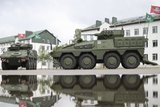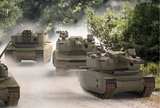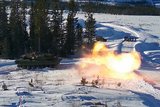DARPA greenlights eight firms for GXV-T
DARPA has awarded contracts for its Ground X-Vehicle Technology (GXV-T) programme to eight organisations, it announced on 26 April.
The contracted organisations are: Carnegie Mellon University, Honeywell International, Leidos, Pratt & Miller, QinetiQ, Raytheon BBN, Southwest Research Institute and SRI International. They will be involved in developing technologies to make future fighting vehicles safer and more affordable, effective and mobile.
The GXV-T programme is pursuing research in four technical areas: radically enhanced mobility, survivability through agility, crew augmentation and signature management. The US Marine Corps and US Army have expressed interest in the future capabilities developed through this programme.
Radically enhanced mobility covers wheel/track and suspension technologies for faster on-road and off-road travel and ability to drive across a wider range of off-road terrain. Survivability through agility covers autonomous threat avoidance, such as active armour repositioning and agile motion. Capabilities of interest include horizontal and vertical armour movement to combat incoming threats in real time.
Crew augmentation refers to improvements in electronically assisted and physical situational awareness for crew and passengers, and semi-autonomous driver assistance and crew function automation. Capabilities of interest here include 360-degree, high-resolution data visualisation from multiple sensors. Signature management refers to reducing acoustic, electromagnetic, visible, infrared and other detectable signatures, including improvements in detection avoidance and engagement by adversaries.
Maj Christopher Orlowski, program manager, DARPA, said: 'We're exploring a variety of potentially groundbreaking technologies, all of which are designed to improve vehicle mobility, vehicle survivability and crew safety and performance without piling on armour.
'DARPA's performers for GXV-T are helping defy the 'more armour equals better protection' axiom that has constrained armoured ground vehicle design for the past 100 years, and are paving the way toward innovative, disruptive vehicles for the 21st Century and beyond.'
More from Land Warfare
-
![Hungary set to begin using Hero 400 loitering munitions]()
Hungary set to begin using Hero 400 loitering munitions
Developed by Israel's Uvision and with systems being sold in the thousands to multiple European NATO countries and the US, the Hero family of loitering systems is also in production in the US and Italy, the latter through Rheinmetall.
-
![Croatia orders Leopards and CAESAR howitzers as Lithuania orders more CAESARs]()
Croatia orders Leopards and CAESAR howitzers as Lithuania orders more CAESARs
The Leopard is becoming the tank of choice in central and eastern Europe as Croatia joins Lithuania, the Czech Republic and Hungary in ordering the platform. Lithuania and Croatia have also signed for CAESAR howitzers.
-
![Light Reconnaissance Strike – enabling a vital mission set (Studio)]()
Light Reconnaissance Strike – enabling a vital mission set (Studio)
A new system-of-systems concept will unlock digital integration of sensors and weapons for Light Forces, allowing them to shape the battlefield environment on their own terms and upgrade legacy platforms.






















